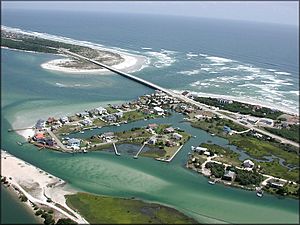Massacre at Matanzas Inlet facts for kids

The Massacre at Matanzas Inlet was a terrible event in 1565. Spanish soldiers killed many French soldiers near the Matanzas Inlet. This happened because Pedro Menéndez de Avilés, the leader of Spanish Florida, ordered it.
Contents
Spain's Claim to Florida
In the 1500s, Spain claimed a huge area. This included what is now Florida and much of the southeastern United States. Spanish explorers like Juan Ponce de León and Hernando de Soto had visited the area.
Spain tried many times to build lasting settlements in Florida. But they kept failing. Then, in September 1565, Menéndez founded St. Augustine. This new Spanish town was about 30 miles south of a French settlement. The French had built Fort Caroline on the St. Johns River.
Menéndez didn't know the French were already there. When he found out about Fort Caroline, he decided to act fast. He wanted to remove the French, whom he saw as outsiders and people with different religious beliefs.
The Storm and the Attack
The French leader, Jean Ribault, soon learned about the Spanish. He also decided to attack quickly. He sailed south from Fort Caroline with most of his soldiers. He was looking for the Spanish settlement.
But a big storm hit his ships. It was probably a tropical storm. Most of the French force was lost at sea. Ribault and hundreds of survivors were shipwrecked. They had little food or supplies. One group was about 15 miles south of the Spanish colony. Ribault's group was even farther south, near Cape Canaveral.
Meanwhile, Menéndez marched north. He attacked Fort Caroline. He easily defeated the few French soldiers left there. He killed most of the French Protestants in the town. Then, he left some Spanish soldiers to guard the fort, which he renamed Fort Mateo.
When Menéndez returned to St. Augustine, he heard news. Ribault and his soldiers were stranded to the south. Menéndez quickly moved to attack them. He killed the French soldiers in two separate groups. This happened on the shore of what became known as the Matanzas River. He only spared the Catholics and a few skilled workers among the French.
Why the Massacre Happened
Menéndez returned to St. Augustine that same night. Some people there thought he was cruel. They were worried about a French attack. But they also had very little food. If they had taken in all the French prisoners, everyone might have starved.
Other Spanish people thought Menéndez had done the right thing. They believed he was a good captain. They also felt that the French, who were Protestants, were a threat. One Spanish professor even said Menéndez acted like a good "inquisitor." This meant he was protecting the Catholic faith.
King Philip II of Spain agreed with Menéndez. He wrote that Menéndez "has done well" to kill those he did. He also said that any French survivors should be sent to work on ships. The King worried that the French Protestants might spread their beliefs to the native people.
Menéndez himself wrote to the King. He said that only a few French people were still alive in Florida. He planned to make sure almost none would remain. He would even get his Indian friends to help.
The Name Matanzas
After October 12, 1565, the inlet where the killings happened became known as Matanzas. This Spanish word means "slaughters."
Today, Fort Matanzas National Monument, the Matanzas River, and the Matanzas Inlet all get their names from this event.
Images for kids


